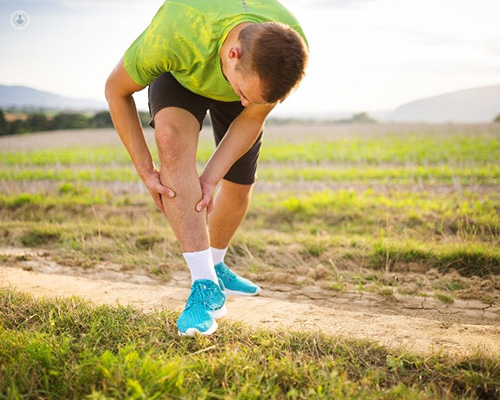The 6 most common sporting injuries – and when they happen
Escrito por:In my practice, I see a wide range of patients with sporting injuries, particularly in the knee and ankle. If you want to avoid a sporting injury it’s very important to understand when they can happen, so here’s a round-up of some of the most common injuries we see:
Muscle injury
By far the most common types of sport injuries is a muscle injury. Bruising and contusion around the muscle are very common in most types of injury, but usually, this will settle down and does not require any intervention. However, there is technology out there that can reduce suffering and treat symptoms as you recover.

ACL rupture
Anterior cruciate ligament (ACL) rupture is a very common injury in younger patients, and usually happens in a non-contact environment.
For example, when a player is trying to turn and cut on a hard ground, or when they’re wearing studs on their feet causing their foot to get in the ground, their body goes one way and their foot is still stuck. This creates tremendous twisting energy and can cause a rupture of the ACL. With this type of injury, the patient will feel a “pop” inside the knee and the knee will swell immediately.
Luckily, it can be managed without surgery and with time things will settle down. There are different braces that we can use to treat it, and with strong muscle, physiotherapy will help. It is best to seek medical advice and to discuss treatment options.
Ligament injury
Ligament injury, or sprain , occurs on the ankle more often than the knee. Most of the time, a sprain can be treated with conservative management, but it depends on the severity of the sprain. There are different technologies out there that can help to reduce the pain after this type of injury, and functional bracing is very important. Early treatment is key to recovery.
Patellar knee injury
There are many different causes of pain in the front of the knee – including from the tendons, the cartilage or the fat pad itself. It can be caused by repetitive strain injury which commonly comes from running, or sometimes it could be fat pad impingement or plica impingement. Patellar knee injury often occurs when someone has changed the sport they play or changed the way that they walk.
This type of injury often settles on its own. However, if it doesn’t settle, we may need to intervene with injection therapy or surgical intervention.
Meniscus injury
Meniscus injury comes hand in hand with cartilage injury (see below) and occurs when there is significant trauma to the knee, causing a tear in the meniscus.
The meniscus is very different in younger and older patients. When we’re younger the meniscus is more flexible so it can deform and it will spring back to how the shape of the meniscus used to be. However, when we become older the meniscus becomes more brittle and trauma to the knee will cause a tear. Usually, this causes severe sharp pain and stops the player from carrying on with their sport.
This type of injury is extremely common in tennis or in golf, which involves a lot of twisting within the body. Nowadays, with modern bracing or injection therapy, surgery is not always necessary to treat this type of problem, and it may be possible for the meniscus to be repaired instead of simply cut off.
Cartilage injury
Cartilage injury is common and usually caused by trauma.
Recovery depends on the different grades of injury. Most of the time the injury recovers with simple contusion. However, if there is further injury to the cartilage, the cartilage can float around the knee and cause a problem. This defect can lead to early-onset arthritis. Luckily, in recent years new treatment options have become available to repair the cartilage or help the body to stimulate growth of new cartilage.
Professor Paul Lee is a consultant orthopaedic surgeon and sports medicine specialist with significant experience in treating injuries of the knee. To book a consultation with Professor Lee, click here.


